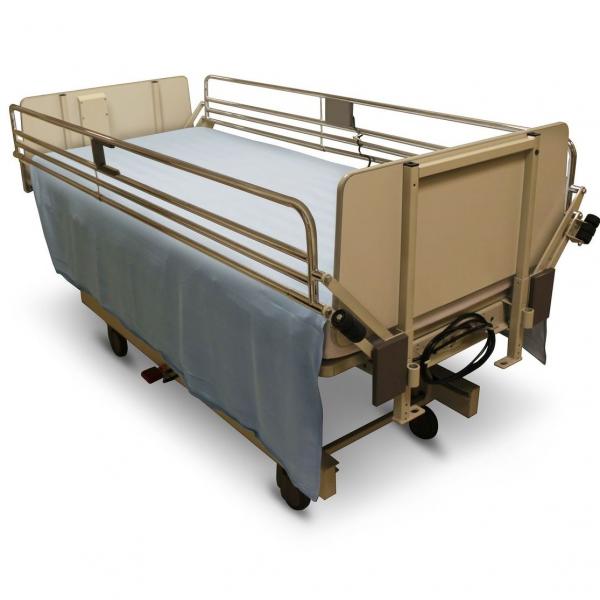Side-tracked by side rails
 When the alarm clock rings, most of us can enjoy those last remnants of sleep, choosing whether or not to hit the snooze alarm. We can decide when and how to get out of bed and start the day. But, how do nursing home residents feel when they awaken to see cold, impersonal side rails? Like a prisoner? Like a burrito? And, what dangers are lurking in the use of those seemingly innocuous bed rails? The use of side rails can indeed be a double-edged sword.
When the alarm clock rings, most of us can enjoy those last remnants of sleep, choosing whether or not to hit the snooze alarm. We can decide when and how to get out of bed and start the day. But, how do nursing home residents feel when they awaken to see cold, impersonal side rails? Like a prisoner? Like a burrito? And, what dangers are lurking in the use of those seemingly innocuous bed rails? The use of side rails can indeed be a double-edged sword.
Both the U.S. Consumer Product Safety Commission (CPSC) and the Food and Drug Administration (FDA) have received many death and injury reports related to side rails. (The terms “side rails” and “bed rails” are used interchangeably.) According to the FDA, 803 incidents were reported where patients/residents were caught, trapped, entangled or strangled in beds with rails between 1985 and January 1, 2009. The FDA notes that of those 803 incidents, 480 people died while 138 sustained nonfatal injuries. An additional 185 patients were not injured because staff intervened. Most of the deaths and injuries occurred to fairly typical residents who were frail, elderly or confused.
After years of safety alerts issued by the FDA, resident deaths and injuries related to side rails remain a concern. Because of the ongoing problems associated with side rails, the FDA, the CPSC and the Administration for Community Living (ACL) posted new guidances related to side rail safety in 2014.
Lessons Learned
A recent case where a resident died after his head became “wedged” between his side rails illustrates the many lessons facilities can learn. [Disclaimer: the author represented CMS in that case and a further appeal, which upheld CMS’ determination of immediate jeopardy.] In the case of Laurelwood Care Center v. CMS, CR1796, a resident was found without pulse or respirations with his head literally “wedged” between the side rails of his bed. The 64-year-old resident was severely cognitively impaired and had a seizure disorder. He was 4’10”, weighed 120 pounds and required complete care. According to his medical records, he was incapable of voluntary movement. Yet, the physician, who was also the medical director, ordered side rails. [Editor's note: The Laurelwood Care Center involved in the above case is located in Johnstown, Pa.]
On cross-examination, the physician admitted that he did not participate in any risk/benefit analysis regarding the use of side rails for this particular resident. Nor could he recall any discussions with the staff regarding the resident’s need for side rails.
The physician testified that the placement of side rails in this instance was “within the standard of care.” Yet, no appropriate risk/benefit analyses or individualized safety risk assessments regarding the use of side rails had been done for any of the 54 residents. Neither the administrative law judge (ALJ) nor the judges on a further appeal accepted the physician’s assertion.
Going From Bad to Worse
When the surveyors went to the facility to investigate the entrapment-related death, they made some stunning observations.
- All residents in the surveyors’ sample had been given written physician orders for side rails.
- The side rails at the facility had an 8-inch gap between the bars–much wider than the 4 ¾-inch gap recommended by the FDA.
- All residents remained in beds with side rails–even after a resident had died from a side rail-related event.
- None of the residents had undergone an acceptable individualized safety risk assessment concerning side rails.
Further, the surveyors observed a document posted at the nurses’ station which read, “Starting today, when a new admission comes in, write the preventative order as … Side Rails up X 2 for transfers/repositioning.” The document was admitted into evidence and as the ALJ noted, the facility’s practices “reflected its bias in favor of side rails… side rails were affixed to every bed.” The 8-inch gaps between the bars provided additional support for an immediate jeopardy deficiency.
Those who testified on behalf of the facility made things worse by not being forthright, in the judges’ opinion. Testimony included statements from the facility’s medical director and director of nursing, the county coroner, a pathologist, a corporate quality assurance nurse and and others. However, the ALJ found their testimony unconvincing and in some cases, as with the county coroner, “ranging from evasive to incredible.”
According to Dr. Karl Steinberg, a board member of the AMDA—The Society of Post-Acute and Long-Term Care Medicine (AMDA) and vice-chair of AMDA’s Public Policy Committee, “It's surprising that in the 21st Century, any facility would be using essentially a standing, blanket order for side rails on all residents—especially considering what we have long known about [side rail] risks.” Dr. Steinberg adds, “Clearly, there are some situations where side rails may be indicated as an aid to bed mobility, and perhaps rare situations where a case could be made for their use to prevent rolling out of bed. However, it's critical to evaluate each case individually, and when considering the use of side rails as a restraint, I believe it's imperative to obtain informed consent from the resident or responsible party before actually implementing them."
Even if the federal regulations do not require obtaining and documenting informed consent, Dr. Steinberg’s point is well taken. As with other interventions that carry potentially serious adverse consequences, informed consent may shield the physician and the facility from liability.
Recommendations
As noted by bed safety expert Beryl Goldman, PhD, RN, NHA during the trial of the case above, “Side rails should be the exception, not the norm.” Dr. Goldman, who is also a member of the FDA’s Hospital Bed Safety Workgroup, adds, “An individualized safety risk assessment should be performed on any resident prior to using side rails.”
It is essential that a risk-benefit analysis be performed (and documented) that justifies the reason for side rails. Additionally, the documentation should include the reasons why other, less restrictive and less dangerous devices or interventions were considered but not used instead of side rails.
This checklist can help facilities avoid gaps in documentation and safety protocols:
- Review and follow the manufacturer’s instructions when using side rails
- Consider alternatives to side rails and document why other methods are not in use
- Reassess the need for continuing side rails and care plan accordingly
- Use the minimum number of side rails and lower one of more sections of a side rail, as appropriate
- Eliminate or minimize the gaps between the mattress and the side rails
- Ensure that all affected staff understand that not all side rails, mattresses and bed frames are interchangeable and/or compatible
- Use the appropriate size mattress or a mattress with elevated edges to prevent entrapment between the mattress and the side rail
- Continually assess (and document) whether and why side rails are necessary for a particular resident and re-evaluate if the specific equipment is best suited for an intended purpose
- Educate all staff and visitors regarding the potential dangers associated with side rails
- Ensure that the risk of entrapment is minimized by evaluating the side rails, gaps between the side rails, the side rails and the mattress and remove potential fall and entrapment hazards
- Consider obtaining informed consent from the responsible party or legal guardian
- Be familiar with the recommendations from the FDA’s Hospital Bed Safety Work Group and guidance such as, but not limited to:
- Recommendations for Health Care Providers about Bed Rails
- Hospital Bed System Dimensional and Assessment Guidance to Reduce Entrapment
- Clinical Guidance for the Assessment and Implementation of Bed Rails in Hospitals, Long Term Care Facilities, and Home Care Settings (April 2003)
A guiding principle when considering the use of side rails should be whether the benefits outweigh the potential risks. In order to achieve maximum protection for residents and facilities, careful thought and adequate documentation should support the decision to use side rails.

Alan C. Horowitz, Esq., is a partner at Arnall Golden Gregory LLP, where he focuses his legal practice on regulatory compliance for skilled nursing homes, hospices and home health agencies and manages cases where the Centers for Medicare and Medicaid Services (CMS) has imposed an enforcement action. He is a former assistant regional counsel Office of the General Counsel, U.S. Department of Health and Human Services. As counsel to CMS, he was involved with hundreds of enforcement actions and successfully handled appeals before administrative law judges, the HHS Departmental Appeal Board and in federal court. He also has clinical healthcare experience as a registered respiratory therapist and registered nurse. He can be reached at alan.horowitz@agg.com.
Related Articles
Topics: Alan C. Horowitz , Risk Management











